| Home | Nature Weekly Index |
11 September 2016 | Water Lily | Nymphaea species |
I had been experimenting with different aquatic plants in my mini aquarium to determine which ones were hardy enough to survive a condition with partial natural light and minimal care. So far, two of them had passed the test --- Frogbit (Hydrocharis morsus-ranae) and Java Fern (Microsorum pteropus). The floating Frogbit will not do well if the aquatic snail population is high while Java Fern needed to be changed about every 3 months as it would have been overrun by the algae by then.
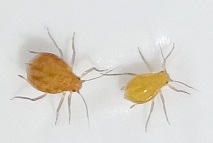 On 23 July, I brought in another 2 aquatic plants --- a small
Water Lily (Nymphaea species) and
a handful of floating Hornwort (Ceratophyllum demersum). When I
opened the pack of Water Lily, I saw tiny creatures crawling on the plant. To my horror, the whole plant was infested
with aphids, similar to the one that I found on the floating Frogbit
back in July 2015. The Water Lily with 3 leaves was clearly of
poor health. I did not examine the plant closely earlier at the aquarium shop. Anyway, I dusted off the aphids and planted
it in my mini aquarium tank. No aphid would survive since the whole plant was submerged in the water. My only worry was that
the aphid might move on to the Frogbit again. Fortunately, it did not happened. To my surprise, the Water Lily not only
survive the aphid attack but also started to thrive in the water, producing new leaves. By today, it had 10 leave; 6
submerged in and 4 floated on the water. The longest length of the floating leaf was about 6 centimetres.
On 23 July, I brought in another 2 aquatic plants --- a small
Water Lily (Nymphaea species) and
a handful of floating Hornwort (Ceratophyllum demersum). When I
opened the pack of Water Lily, I saw tiny creatures crawling on the plant. To my horror, the whole plant was infested
with aphids, similar to the one that I found on the floating Frogbit
back in July 2015. The Water Lily with 3 leaves was clearly of
poor health. I did not examine the plant closely earlier at the aquarium shop. Anyway, I dusted off the aphids and planted
it in my mini aquarium tank. No aphid would survive since the whole plant was submerged in the water. My only worry was that
the aphid might move on to the Frogbit again. Fortunately, it did not happened. To my surprise, the Water Lily not only
survive the aphid attack but also started to thrive in the water, producing new leaves. By today, it had 10 leave; 6
submerged in and 4 floated on the water. The longest length of the floating leaf was about 6 centimetres.
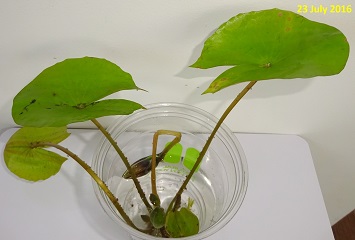
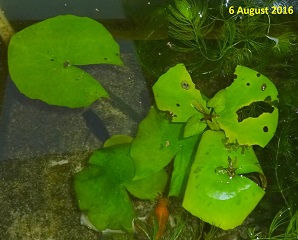
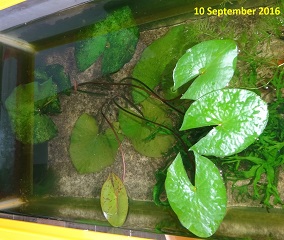
Two of the original leaves detached from the stalk and started to float around. Since they were still green, I had left them in the water. Soon, something started to grow from the junction where the leaf stalk attach to the leaf blade. On close examination, it was a new plantlet. I was not aware that Water Lily was able to undergo vivipary, a phenomenon whereby baby plants grew on the parent plant.
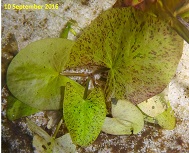
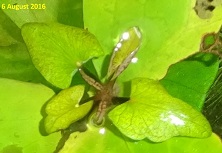 Further investigation indicated that this Water Lily might be a hybrid between Nymphaea caerulea and
Nymphaea micrantha. It appeared that Nymphaea micrantha is the only Water Lily that exhibit vivipary. Any
crossbreed with this species will result in a hybrid that kept the vivipary property. According to an
article published in 2011, hybrid
Water Lily was an invasive plant in Sri Lanka, displacing the native species relatively fast. One of my viviparous plantlet
was consumed by the snails. I planted the other one in the bottom of a tank with few snails and after a month, it seemed to
be growing. This hybrid species will indeed spread quickly given the right condition. I was wondering whether my Water
Lily will eventually flower.
Further investigation indicated that this Water Lily might be a hybrid between Nymphaea caerulea and
Nymphaea micrantha. It appeared that Nymphaea micrantha is the only Water Lily that exhibit vivipary. Any
crossbreed with this species will result in a hybrid that kept the vivipary property. According to an
article published in 2011, hybrid
Water Lily was an invasive plant in Sri Lanka, displacing the native species relatively fast. One of my viviparous plantlet
was consumed by the snails. I planted the other one in the bottom of a tank with few snails and after a month, it seemed to
be growing. This hybrid species will indeed spread quickly given the right condition. I was wondering whether my Water
Lily will eventually flower.
As for mass of floating Hornwort, it had no problem adapting to the environment in the mini aquarium, doing very starting day one and had been growing fast. I had to trim it each week to make sure that it did not blanket the entire surface of the tank. The snails loved and their eggs started lining its length. The cleaning routine each week now included moving the entire Hornwort to a pail of water and shaking off the snails. Yesterday, I had decided to remove it since there was no way for it to co-exist with the Water Lily in the small tank and I would prefer to keep the Water Lily.